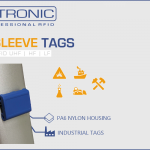Industry Talk
Regular Industry Development Updates, Opinions and Talking Points relating to Manufacturing, the Supply Chain and Logistics.How Retailers Can Stay Ahead in the Mobile-first Era

Mobile commerce has had a significant effect on the way people shop, and is now considered an important part of the retail experience. It is expected that revenue from mobile commerce will reach around $2.5 trillion during 2025, nearly doubling over the previous 4 years, and representing a staggering 63% of total retail ecommerce. In the UK alone, it is expected to surpass £109 billion by 2027, highlighting just how dominant online shopping has become. A key reason for this shift is changing consumer behaviour, with 95% of the UK population owning a smartphone and seven in ten shoppers now preferring to browse and purchase goods and services via their phones rather than on a computer. Times have changed, and retailers must adapt to stay ahead.
However, this change in habit is not just about convenience for consumers. It is also forcing retailers to rethink how they themselves operate. Consumers now expect a seamless and joined up journey when they are shopping, whether they are finding products while browsing TikTok, for example, researching them more thoroughly on a desktop computer, or completing a purchase on their mobile phone.
In order to meet this challenge, retailers need a fundamental rethink of managing inventory, streamlining checkout processes, and engaging with consumers too. A strong strategy to stay competitive in light of these changes lies in adopting the right technologies to create a seamless and integrated shopping experience for consumers as Chris Timmer discusses below…
Overcoming Mobile Shopping Challenges with Automation
One of the biggest challenges retailers face as a result of the increase in mobile shopping is ensuring accurate and up to date real-time inventory management across all touchpoints. The advent of mobile shopping has meant that customers are now able to browse and buy at any time, in any place, meaning stock levels must be kept continually up to date across all platforms to avoid overselling or disappointing customers.
One surefire way to frustrate a would-be customer is to have them select a product, enter their details and information, only to find out at checkout that it is out of stock. To prevent this, retailers need to integrate their inventory management systems across all sales channels and touchpoints, ensuring that stock availability is synchronised irrespective of where a customer is shopping: either via an app, a website, or in-store. Failing to do so can lead to lost revenue, as consumers switch to competitors and abandon their purchases altogether.
In order to address this, many retailers are turning to order management in order to meet rising consumer expectations for speed and efficiency. Fast fulfilment has become an expectation across a number of industries, and around two thirds of global shoppers now expect delivery within 24 hours. This is understandably a tall order for retailers, and means having the infrastructure in place to process orders quickly and accurately, including working with reliable 3PL providers to facilitate these deliveries and to handle stock across regions.
Smart retail technology platforms can help streamline operations by centralising order tracking, warehouse management, and customer notifications into a unified platform, resulting in reduced errors and an improved post-purchase experience as a result. Frustrating prospective customers with delays, missed deliveries, and incorrect shipments risks putting them off, and perhaps even losing them for good off the back of their poor experience.
Tackling Online Cart Abandonment
Another hurdle to overcome for online retailers is the issue of cart abandonment, with nearly 70% of shoppers failing to complete their purchases online. While some of this can be attributed to customers browsing for leisure with no intention to buy, a significant portion is due to poor checkout experiences. Ecommerce shoppers, and mobile users in particular, are quick to abandon their carts if the process is too long, complex, or lacking preferred payment options such as Google Pay and Apple Pay. Retailers are perhaps already aware of the challenges of converting mobile baskets into sales, with around 85% failing to actually pay and checkout with the goods they’ve selected. This is therefore a clear area for improvement for businesses looking to improve sales and ultimately the bottom line.
A seamless checkout experience is critical to converting mobile shoppers. One-click purchasing, such as that seen on Amazon with digital payment methods including Apple Pay and Google Pay, alongside guest checkout options, can help speed up the process and reduce friction and frustration. Equally important within this is ensuring strong connectivity to and from platforms such as Shopify, BigCommerce, and Magento, where many direct to consumer (D2C) sites are built, as well as the broader commerce operations ecosystem. By integrating these platforms into a unified and connected commerce strategy, retailers can provide a consistent checkout experience across all checkpoints.
Related to this, consumers also expect transparency in pricing. Hidden fees, such as unexpected shipping costs or administrative costs revealed at checkout often lead to abandoned purchases and a negative experience for shoppers. And with recent government legislation banning hidden fees in other industries, it is wise that retailers consider prioritising price transparency by clearly displaying all costs upfront in order to ensure compliance and build trust with consumers to encourage order completion.
Adding to the challenges retailers face in converting mobile sales is cart abandonment caused by website performance. Older, poorly designed websites with slow-loading pages, unresponsive design elements, and complex forms can all put mobile shoppers off. Optimising mobile sites for speed and ease of navigation on a mobile device, along with implementing autofill features for payment and shipping details, can create a faster and more stress-free shopping experience.
The power of AI and Personalisation in Encouraging Consumer Engagement
Another key differentiator for retailers today is personalisation. Consumers are far more likely to engage with brands that understand their preferences, and advancements in AI are helping retailers deliver these tailored experiences at scale. By analysing browsing habits, past purchases, and individual interests, businesses can offer personalised product recommendations and targeted promotions that feel relevant and valuable to each shopper.
Social commerce, where consumers discover and purchase products directly through platforms such as TikTok, is also becoming more popular over recent years. Retailers who integrate AI-driven personalisation with their social commerce strategy can create a more engaging shopping experience for their customers. For example, these businesses may consider deploying ads that change based on specific user behaviour, or AI chatbots, that are capable of offering bespoke product suggestions in real time, both of which can improve customer interaction with the business and ultimately drive higher conversions.
Beyond marketing, AI-enabled tools also have the potential to speed up processes elsewhere behind the scenes. One potential avenue to explore is the use of AI chatbots to respond to FAQs, reducing wait times for customers with more complicated requests, and improving service levels. Similarly, machine learning algorithms can help retailers predict demand more accurately, which helps to improve stock management and reduces the risk of overstocking or running out of popular products that can frustrate customers and damage a business’s reputation.
Conclusion
Mobile commerce is now firmly established as a new norm in online shopping behaviours. Consumers now expect seamless, fast, and personalised experiences, and retailers must adapt to these demands or risk falling behind. Those that integrate real-time inventory management, optimise checkout processes, and leverage AI to tailor shopping experiences will likely be those winning business at the expense of their competitors as consumer expectations change.
Refining a business’s digital infrastructure undoubtedly takes time and effort, but automation offers a large helping hand for retailers looking to improve the customer experience and drive sales










